
What is glaucoma in a dog?
You might notice your dog squinting more at mealtime or avoiding bright sunlight—these small changes could be early signs of a serious eye condition.
Waking up to find those little crusty specks in your dog’s eyes can leave any new pet parent scratching their head. Maybe you’ve got a bouncy Labrador puppy who greets you with a wagging tail at dawn, or a laid-back Basset Hound who takes forever to rise—either way, that morning eye gunk probably has you wondering if it’s something to worry about. Let me put your mind at ease: in most cases, it’s totally normal, but let’s dig into why it happens and how to handle it.
Your dog’s eyes, much like yours, produce tears to stay lubricated and flush out tiny irritants—think dust from the living room rug, a stray blade of grass from yesterday’s park trip, or even pollen drifting through open windows. At night, when they’re deep in doggy dreams, their tear production slows down, causing that fluid to thicken a bit. By morning, it dries into those small, usually clear or light brown clumps. It’s basically their eyes doing a little cleanup while they snooze. Breeds with big, prominent eyes—like Shih Tzus or Boston Terriers—often get more because their eyes are more exposed to the elements, but it’s rarely a cause for concern.
So, how do you gently take care of it? Grab a soft, damp cloth—skip the kitchen towel and opt for something gentle, maybe a fragrance-free baby wipe—and wipe from the inner corner of their eye outward. Take it slow: if they pull away, pause and try again later with a treat. A friend of mine, Sarah, rushed this with her Dachshund once, and the poor pup ended up squirming so much he irritated his eye. Make it a calm routine, maybe right after their morning ear scratch. Never use human eye drops unless your vet gives the go-ahead; some have ingredients that can sting their sensitive eyes.

Let’s talk about being a responsible dog owner, which matters a lot here in the U.S. First off, keep those vaccines up to date—rabies shots are legally required in every state, and many cities ask for proof if your dog interacts with others at the park. When you’re out for walks (which actually help reduce eye gunk by getting fresh air flowing), always bring poop bags. In cities like New York, not cleaning up after your dog can land you a fine of $250 or more, and it’s just respectful to your neighbors.
Building trust is key. If your dog hates having their eyes touched, never shout or tap their nose—that’ll only make them scared of the process. Instead, use positive reinforcement: offer a tiny piece of peanut butter (unsalted, of course) after each successful wipe. My trainer pal Mike uses this with his rescue Greyhound, who used to hide under the table when he saw the cloth. Now he sits patiently, tail thumping, because he knows a snack is coming. Dogs respond to kindness, not punishment—that’s not just good practice, but a big part of our culture of raising happy, well-adjusted pups.
If you’re in an apartment, pay attention to your space. Dry air from AC or heaters can irritate their eyes, so a small humidifier near their bed might cut down on morning gunk. Also, follow community rules: most apartment buildings require leashes in hallways, and some have specific hours for dog walks to avoid disturbing neighbors early in the day. In shared parks, keep your dog close—letting them run into overgrown bushes can mean more pollen in their eyes, leading to more crust by morning.
Of course, watch for red flags: if the gunk is yellow or green, if their eyes are red or swollen, or if they’re squinting a lot. That could signal an infection, and a vet visit is a must. But for most of us, those morning eye bits are just part of the package of loving a dog—one more small, messy, wonderful part of life with your furry friend.

You might notice your dog squinting more at mealtime or avoiding bright sunlight—these small changes could be early signs of a serious eye condition.

Let’s set the scene: It’s a sweltering Phoenix afternoon—105°F outside—and you rushed your 2-year-old Lab mix, Cooper, on a quick walk to “get it over with.”

Let’s get real: You’re in your Miami apartment, watching your 3-year-old Corgi, Loki, struggle to climb the stairs to your second-floor unit.

Many dog owners brush off occasional scratching as just “dog behavior,” but persistent itching often signals something more—like a food allergy.

You might first notice your dog scratching more than usual—chewing at their paws until the fur looks thin, or rubbing their face against the couch nonstop.

Let’s be real: You’re standing in your Chicago apartment, watching your 3-year-old Beagle, Max, huff and puff just to climb onto the couch.